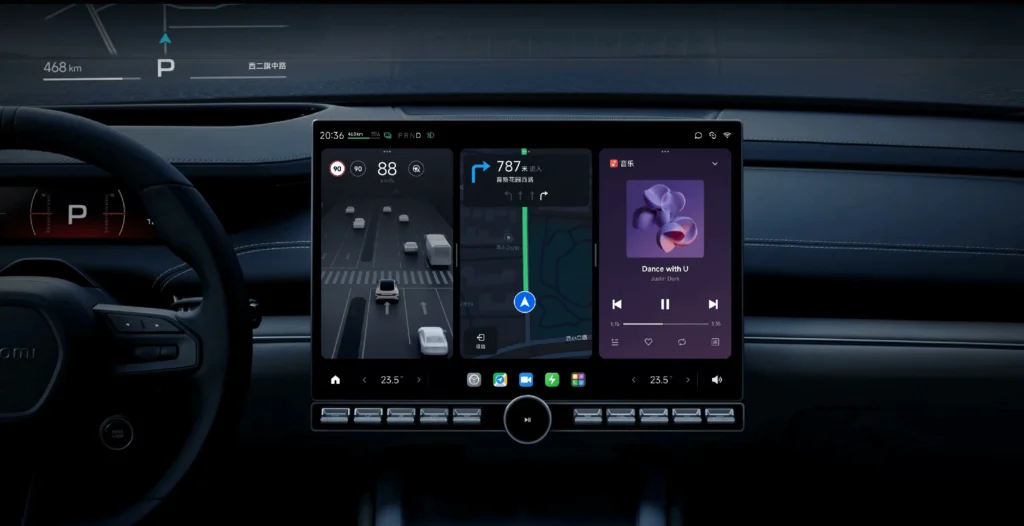Understanding Automotive-Grade Displays
An automotive-grade display is a screen designed and manufactured to meet the rigorous demands of the automotive industry. Unlike consumer devices such as smartphones or tablets, vehicle environments are harsh:
- Wide temperature variations (from winter cold to summer heat).
- Constant vibration and shock.
- Long product life cycles (10+ years).
- Strict safety and reliability standards.
Therefore, automotive-grade displays must combine robust durability, stable performance, and compliance with international automotive standards.
Why Standard Consumer Displays Aren’t Enough
Consumer electronics panels focus on cost-effectiveness and short refresh cycles. They may work well indoors but fail quickly in a car due to:
- Limited temperature tolerance (typically 0°C to 40°C).
- Lower brightness unsuitable for direct sunlight.
- Short product lifetimes (2–3 years).
- Insufficient vibration resistance for road conditions.
By contrast, automotive-grade displays are engineered for long-term, mission-critical performance.
Key Characteristics of Automotive-Grade Displays
Wide Operating Temperature Range
Automotive-grade displays are built to withstand temperatures from -40°C to +85°C, ensuring reliable operation in diverse climates.
High Brightness and Sunlight Readability
Typical brightness levels exceed 800–1000 cd/m², combined with anti-reflective coatings, ensuring visibility even in direct sunlight.
Extended Lifespan
Designed for 10–15 years of operation, these displays far outlast consumer-grade panels.
Vibration and Shock Resistance
Displays undergo rigorous mechanical testing to ensure they can survive road vibration, engine resonance, and impacts.
Wide Viewing Angles
With IPS or advanced TFT technology, displays maintain clear readability from multiple driver and passenger angles.
Functional Safety Compliance
They often support ISO 26262 standards, meaning display failures won’t compromise vehicle safety.
Industry Standards and Certifications
To be considered “automotive-grade,” displays must comply with strict standards, such as:
- AEC-Q100/Q200 – Reliability standards for automotive electronic components.
- ISO 16750 – Road vehicle environmental conditions and testing.
- ISO 26262 – Functional safety requirements.
- EMC/EMI Compliance – Ensures displays do not interfere with other vehicle systems.
These certifications guarantee that a display can function under real-world automotive conditions.
Types of Automotive Displays
Instrument Cluster Displays
Replaces analog dials with high-resolution digital dashboards, often using TFT or OLED.
Infotainment Displays
Central control units for navigation, entertainment, and vehicle settings.
Head-Up Displays (HUDs)
Projects essential driving information onto the windshield for minimal distraction.
Passenger Displays
Luxury cars may include co-driver or rear-seat entertainment screens.
Each type requires specific touch ICs, brightness levels, and safety standards.
Challenges in Automotive Display Design
Even for engineers, designing or integrating automotive displays presents challenges:
- Heat Management: High brightness creates significant thermal stress.
- Touch Sensitivity: Must work with gloves, wet fingers, or stylus.
- Longevity of Supply: Automotive projects require guaranteed component availability for years.
- Cost vs. Reliability: Balancing affordability with stringent automotive standards.
Future Trends in Automotive-Grade Displays
The automotive display industry is evolving rapidly, with innovations such as:
- OLED Automotive Displays – Higher contrast, deeper blacks, and flexible designs.
- Mini-LED Backlighting – Brighter, more energy-efficient screens.
- Curved and Freeform Displays – Integrating seamlessly with dashboard design.
- Augmented Reality HUDs – Projecting navigation and safety data directly into driver’s line of sight.
As autonomous driving advances, display technologies will play an even more critical role in user interaction.
Conclusion
An automotive-grade display is far more than a regular screen — it is a highly engineered solution built to endure extreme conditions, ensure driver safety, and deliver a premium in-vehicle experience.
By meeting strict reliability, safety, and environmental standards, these displays enable the automotive industry to confidently move toward smarter, safer, and more immersive driving experiences.

